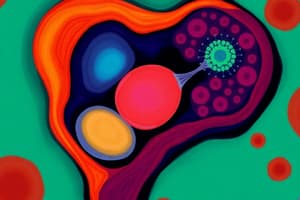Podcast
Questions and Answers
Durante la segmentación, ¿qué ocurre con el citoplasma de los blastómeros?
Durante la segmentación, ¿qué ocurre con el citoplasma de los blastómeros?
- El citoplasma se divide en partes iguales entre los blastómeros
- El citoplasma aumenta gradualmente
- El citoplasma se reduce con cada división (correct)
- El citoplasma permanece constante
¿Qué condición limita el proceso de segmentación?
¿Qué condición limita el proceso de segmentación?
- La temperatura del ambiente
- La falta de oxígeno
- La disponibilidad de nutrientes
- La disminución del citoplasma (correct)
La blástula, o blastocisto, se forma aproximadamente en el día del desarrollo embrionario.
La blástula, o blastocisto, se forma aproximadamente en el día del desarrollo embrionario.
- 3
- 5 (correct)
- 1
- 7
¿Cuál de estas estructuras es responsable de la anidación del blastocisto en el endometrio?
¿Cuál de estas estructuras es responsable de la anidación del blastocisto en el endometrio?
¿Cuál de las siguientes estructuras NO forma parte del embrión?
¿Cuál de las siguientes estructuras NO forma parte del embrión?
¿Qué proceso crucial se activa a medida que el blastocisto se divide?
¿Qué proceso crucial se activa a medida que el blastocisto se divide?
¿En qué etapa del desarrollo se distinguen claramente la masa celular interna (MCI) y la masa celular externa (MCE)?
¿En qué etapa del desarrollo se distinguen claramente la masa celular interna (MCI) y la masa celular externa (MCE)?
¿Cómo se puede caracterizar el proceso de implantación del blastocisto en el endometrio?
¿Cómo se puede caracterizar el proceso de implantación del blastocisto en el endometrio?
Flashcards
Segmentación
Segmentación
El proceso de división celular que ocurre en el cigoto, donde se crea un número creciente de células (blastómeros) con el mismo citoplasma inicial.
Mórula
Mórula
Una masa esférica de células (16-32) que se forma durante la segmentación del cigoto.
Blástula/Blastocisto
Blástula/Blastocisto
Una estructura esférica hueca que se desarrolla a partir de la mórula, con una cavidad interna llamada blastocele.
Masa Celular Externa (MCE)
Masa Celular Externa (MCE)
Signup and view all the flashcards
Trofoblasto
Trofoblasto
Signup and view all the flashcards
Masa Celular Interna (MCI)
Masa Celular Interna (MCI)
Signup and view all the flashcards
Implantación
Implantación
Signup and view all the flashcards
Distancia de la trompa de Falopio
Distancia de la trompa de Falopio
Signup and view all the flashcards
Study Notes
Segmentation and Implantation
- In identical twins, cell segmentation occurs early. In conjoined twins, segmentation happens later.
- After ovulation, the zygote divides mitotically, increasing the number of cells (blastomeres).
- Initial cytoplasm is shared among all cells, but the cytoplasm diminishes as cell numbers increase.
- Segmentation stops until implantation.
- Time from the fallopian tube to the uterus is important for timing.
- Zygote division (blastomere formation) starts about 30 hours after fertilization.
- Day 0: Zygote (single cell)
- Days 1-4: Morula (berry-like; 16-32 cells)
- Days 4-5: Blastula/blastocyst/blastocele
Blastula/Blastocyst Characteristics
- Shape change due to fluid build-up.
- Blastula refers to the immature form while "blastocele" refers to an internal cavity.
- Blastula adheres (implants) to the uterine wall by day 5.
- Outer cell mass (ECM): Involved in anchoring the embryo to the uterine wall. The ECM develops into the trophoblast which is used for nutrition.
- Inner cell mass (ICM): Becomes the embryo/embryonic disc; essential part of the embryo.
- ECM and ICM are initially distinct, but the ICM is the future embryo.
Second Week of Development
- Starting day 8, the blastocyst embeds in the endometrial lining.
- Trophoblast rapidly proliferates and differentiates into:
- Cytotrophoblast
- Syncytiotrophoblast
- ICM (inner cell mass) differentiates into two layers:
- Hypoblast
- Epiblast
- Formation of two cavities:
- Yolk sac (derived from blastocele) lined by hypoblast.
- Amniotic sac lined by epiblast.
Studying That Suits You
Use AI to generate personalized quizzes and flashcards to suit your learning preferences.




